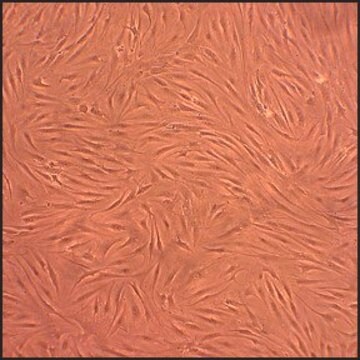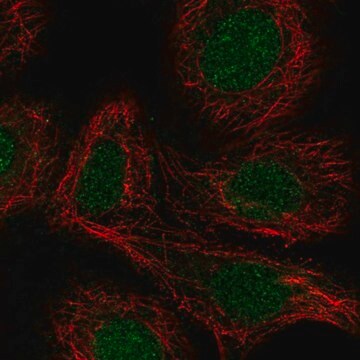LA-N-1
6041201, human nerve, Tear-drop shaped
Synonym(e):
LAN 1 Cells, LAN1 Cells
Anmeldenzur Ansicht organisationsspezifischer und vertraglich vereinbarter Preise
Alle Fotos(1)
About This Item
UNSPSC-Code:
41106514
Empfohlene Produkte
product name
LA-N-1, 06041201
Biologische Quelle
human nerve
Wachstumsmodus
Semi-adherent aggregates
Karyotyp
Modal no. 87, range 47 - 87
Morphologie
Tear-drop shaped
Produkte
Catecholamine
Rezeptoren
Not specified
Methode(n)
cell culture | mammalian: suitable
Relevante Krankheit(en)
metastasis
Versandbedingung
dry ice
Lagertemp.
−196°C
Ursprung der Zelllinie
Human Neuroblastoma Bone Marrow Metastasis
Beschreibung der Zelllinie
Established by Seeger et al., (1977) from neuroblastoma cells in the bone marrow of a 2-year-old male with clinical Stage IV neuroblastoma. The cells are neuroblastic, tear-drop shaped with multiple short fine cell processes (neurites). The cells are tumourigenic in nude mice. This is a catecholamine producing neuroblastoma cell line.LA-N-1 (Sigma Catalogue number 06041201), LA1-55n (Sigma Catalogue number 06041203) and LA1-5s (Sigma Catalogue number 06041204) have been shown to originate from the same patient by STR profiling.
Established by Seeger et al., (1977) from neuroblastoma cells in the bone marrow of a 2-year-old male with clinical Stage IV neuroblastoma. The cells are neuroblastic, tear-drop shaped with multiple short fine cell processes (neurites). The cells are tumourigenic in nude mice. This is a catecholamine producing neuroblastoma cell line.LA-N-1 (Sigma Catalogue number 06041201), LA1-55n (Sigma Catalogue number 06041203) and LA1-5s (Sigma Catalogue number 06041204) have been shown to originate from the same patient by STR profiling.
DNA-Profil
STR-PCR Data: Amelogenin: X,Y
CSF1PO: 12
D13S317: 11,12
D16S539: 9
D5S818: 12
D7S820: 10,11
THO1: 8,9.3
TPOX: 8,11
vWA: 16,19
CSF1PO: 12
D13S317: 11,12
D16S539: 9
D5S818: 12
D7S820: 10,11
THO1: 8,9.3
TPOX: 8,11
vWA: 16,19
Nährmedium
EMEM (with non-essential amino acids) and Ham′s F12 (1:1 mixture) + 2mM Glutamine + 10% Foetal Bovine Serum (FBS)
Subkultur-Routine
For routine maintenance, split cultures only after they have become very dense i.e. split once every 2-3 weeks at a 1:20 - 1:100 ratio; 8% CO2; 37°C. Cells grow best and are most adherent on a plastic substrate in medium at a pH of 6.9 - 7.2; they do not tolerate more alkaline pH well. Population doubling time is approximately 2 days; saturation density is >1,000,000 cells/cm2. Cells grow in weakly adherent clusters. Allow all floating clumps to settle and withdraw most of the medium. Remove attached cells from substrate with 0.1% trypsin or PBS alone, cells will detach in <5 minutes. Remaining cells, if any, are large, flat and tightly adherent precursors of Schwann cell/glia/melanocyte lineages. If desired they should be removed from the substrate with trypsin/EDTA. When the neuronal cells are seeded into a new flask the cells attach slowly and may remain in suspension for one to several days; do not change the medium the day after passage. Floating clumps of cells are viable. This passage schedule will select for cells retaining a neuroblastic phenotype; cultures transferred more frequently, with larger inocula, and/or with trypsin/EDTA may gradually lose their neuroblastic properties due to overgrowth by spontaneously arising, non-neuronal adherent cell variants. When cells are resuscitated from a frozen ampoule the cells may appear dead after a day, but reattach and resume growth within 2-3 days reaching confluence by 7 days.
Sonstige Hinweise
Additional freight & handling charges may be applicable for Asia-Pacific shipments. Please check with your local Customer Service representative for more information.
Analysenzertifikate (COA)
Suchen Sie nach Analysenzertifikate (COA), indem Sie die Lot-/Chargennummer des Produkts eingeben. Lot- und Chargennummern sind auf dem Produktetikett hinter den Wörtern ‘Lot’ oder ‘Batch’ (Lot oder Charge) zu finden.
Besitzen Sie dieses Produkt bereits?
In der Dokumentenbibliothek finden Sie die Dokumentation zu den Produkten, die Sie kürzlich erworben haben.
Unser Team von Wissenschaftlern verfügt über Erfahrung in allen Forschungsbereichen einschließlich Life Science, Materialwissenschaften, chemischer Synthese, Chromatographie, Analytik und vielen mehr..
Setzen Sie sich mit dem technischen Dienst in Verbindung.


